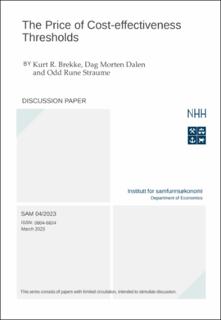| dc.description.abstract | Health systems around world are increasingly adopting cost-effectiveness (CE) analysis to inform decisions about access and reimbursement. We study how CE thresholds imposed by a health plan for granting reimbursement affect drug producers pricing incentives and patients access to new drugs. Analysing a sequential pricing game between an incumbent drug producer and a potential entrant with a new drug, we show that CE thresholds may have adverse effects for payers and patients. A stricter CE threshold may induce the incumbent to switch pricing strategy from entry accommodation to entry deterrence, limiting patients access to the new drug. Otherwise, irrespective of whether entry is deterred or accommodated, a stricter CE threshold is never pro-competitive and may in fact facilitate a collusive outcome with higher prices of both drugs. Compared to a laissez-faire policy, the use of CE thresholds can only increase the surplus of a health plan if it leads to entry deterrence in which the price reduction by the incumbent necessary to deter entry outweighs the health loss to patients not getting access to the new drug. | en_US |
